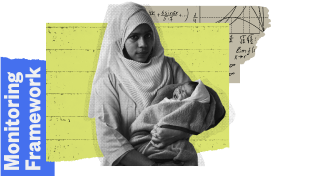Madagascar
Download full country profile
 30,688,120
Total Population
30,688,120
Total Population
A dispute exists between the Governments of Argentina and the United Kingdom of Great Britain and Northern Ireland concerning sovereignty over the Falkland Islands (Malvinas).
The boundaries and names shown and the designations used on this map do not imply official endorsement or acceptance by the United Nations.
Madagascar’s Population dynamics Data


Total Fertility Rate (births per woman)
Adolescent (15-19 years) Birth Rate (births per 1,000 girls)
Maternal Mortality Ratio (Per 100,000 live births)
Madagascar’s national commitment
At the Nairobi Summit, the Republic of Madagascar committed to guaranteeing access to an efficient health system for all in order to achieve the goal of zero preventable maternal deaths. The country committed to building the capacity of service providers, strengthening health facilities’ technical skills in reproductive health and family planning, increasing the availability of contraceptive products, raising awareness of and enforcing the law on reproductive health and family planning at all levels, and setting up mobile clinics.
In Madagascar, unmet need for family planning is higher in rural areas than in urban areas,
and highest among women with no education and women living in the poorest households.
Madagascar’s maternal mortality ratio has been declining from 2000 to 2020, the most recent year for which data is available when it was estimated to be 391 deaths per 100,000 live births.
The maternal mortality ratio is 5.5 times higher than the SDG target of 70 deaths per 100,000 live births.
Among married women 15-49 years who had a live birth in the last two years, approximately 46% of deliveries are assisted by a skilled attendant.
The proportion of births attended by a skilled attendant is higher in urban areas and increases considerably with higher levels of education and household wealth.
In Madagascar, 39% of women aged 20-24 years were married before age 18, with 13% married before age 15.
Marriage before age 18 is higher in rural areas than urban areas (44% versus 21% respectively), and it decreases with higher levels of education and household wealth.
The adolescent birth rate in Madagascar has decreased from 1990 to 2020;
it is highest among women living in rural areas and those women with no education and living in the poorest households and decreases with higher levels of education and household wealth.
34% of women aged 20-24 years had a birth before age 18 including 8% before age 15.
Births before age 15 were higher among women living in rural areas, those with no and primary education, and those living in the poorest households.
Since the Nairobi Summit, a monitoring plan for Madagascar’s ICPD25 commitments has been developed. Efforts have also been made in regard to the commitment of the head of State to family planning – compact commitment and the operation of the integrated care centers for the fight against gender-based violence. The progress towards realizing Madagascar’s ICPD25 commitments was specifically referenced and reflected in the 2021 Voluntary Nation Review at the UN’s High-level Political Forum on Sustainable Development. Some key highlights include the pursuit of leveraging its demographic dividend, the efforts to ensure a conducive local environment, the strengthening of institutional capacities to enforce laws and regulations, and efforts to achieve zero preventable maternal deaths by 2023.












































